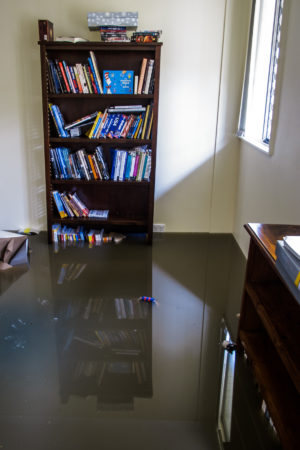and help them get where they want to go.
Last time, we outlined why it’s so easy for people to misunderstand what the Feldenkrais Method is about. We ended with a major key you need to know in order to get more clients:
Your job as a self-employed practitioner is to meet potential clients where they are, just as you would if they were already your clients.
To see how this works, we’re going to do something you have a lot of experience with—take an imaginary trip. So put on your flotation jacket—we’re going to a flood zone… inside your house.
Imagine this…

It’s 3 AM when you wake up and realize that you hear water running.
You go looking for a toilet that didn’t turn off properly and to your horror, you discover that the lower level of your house is flooding… there are already several inches of water obliterating the new carpet in your studio. The legs of your table are soaked, your ATM mats will never be same and all your precious resources on that bookshelf are about to become sodden bricks of blank paper. You look but can’t see a broken pipe.
You take a minute to move some of the most important stuff to higher shelves and then rush to the Internet to find help.
Who is your choice from your very quick Internet search?
How do you decide among 3 plumbers with 5-star ratings?
- Plumber A says he also offers heating and air conditioning, and will install a whole house fan or clear your drains.
- Plumber B says he’s honest, reasonable and fair, and has been voted “Best of” in your local area for 2 years in a row.
- Plumber C says in big bold letters that he offers 24/7 emergency plumbing and drain service and does water damage restoration.
The plain truth: If you didn’t pick “C” without thinking about it, you need to give somebody else the task of dealing with emergencies that happen around you.
And by the way, I didn’t make these guys up… they are the first three that came up when I searched where I live for “plumber.”
The “Known Problem”
I imagine you might think your clients are operating on a different level when they’re looking for you. For one thing, everyone knows what a plumber does, while very few people know what you do.
I can assure you: your clients are not different from the plumber’s clients.

Your clients have a “Known Problem.”
They know what it is.
They can describe it and tell you how it affects them and people around them.
They worry about it.
They talk to their friends about it and people on Facebook know they’ve got it—that’s why this is also called their “public problem.”
What they want help with is dealing with what they know is wrong.
If the known problem has to do with their body, isn’t it natural for them look for someone who does BODYwork?
It’s exactly the same thing that I proposed in the flooding situation. No one in their right mind would stand in the middle of a flooded room while listening to water running and go looking for help from an attorney, an accountant, an electrician, a dog trainer, a barista… or a bodyworker. They certainly would not be inspired to search for someone to help them transform the way they use their brain or live their life.
Nor would someone with a flooded house think that they needed to do anything other than stop the problem. Turn off the water. Drain the studio. Get back to normal.
Nobody wakes up at 3 AM thinking “Gee, wouldn’t it be great to transform our old house by changing out all the pipes?”
It’s this simple for most people:
If the problem has to do with water, look for a plumber.
If it’s an emergency related to water, look for a plumber who says 24/7.
If the problem has to do with your body, look for someone who touches people.
If you feel it in your back, look for someone who touches, who also says they specialize in back pain.
I know this isn’t how you see the problem. But honestly, with the Feldenkrais training you’ve had, you are not a good gauge for how the general population sees things or thinks about our work.
I’ll bet you already know this in your heart of hearts.
It’s just so hard to believe it could be true.
So let’s stop here a for moment, before we get into how you can turn this into what you want. Because what Gloria Steinem said is true—“The truth will set you free but first it will piss you off.”

How KLT helps you get to the next step
Now suppose the plumber does his job, shuts off the water, and while the house is drying out, he starts to have a look. He shows you what happened and tells you that your plumbing is dangerously close to failing in more spots than the one he’s just taken care of… and helps you see the evidence for yourself.
Would you be interested in having him help you deal with all that?
Of course you would! He’s already built his KLT Factor with you. In other words,
You Know him—you saw his website, he answered the phone in the middle of the night, came to your house right away and is now standing there drinking the coffee you made for him at o-dark-thirty.
You Like him—he’s a nice guy who helped you out of a jam when he probably wanted to be sleeping… and he wasn’t even cranky about it.
You Trust him—he showed up in the wee hours, just like he promised and he did what you knew you needed.
The Know-Like-Trust Factor is well documented. Basically it states that any time a person can get what they need from two or more people, they choose the one they know, like and trust—pretty much every time.
The difference that makes a difference
When the plumber heard your address, he said to himself “Whoa, that’s the sub-division where Toilets-R-Us installed all that sub-standard pipe in every one of those houses 15 years ago. This is what… the 4th? 5th? … house of theirs that’s had exactly this same problem. This is just the beginning… Lucky for her I know what the underlying problem is and where to look for it. In the end, what she really needs is to change out her shoddy plumbing so that it’s reliable. Really what I do is ‘transformational plumbing’! Too bad nobody would pay me for that.”
He knows there is no point in his putting what he knows people really need from him front and center on his website because almost no one is looking for it. How many folks search for a plumber to change out every pipe in their house. even if it’s what they really need?
Why? Because most people don’t know there’s any issue at all until the flood comes, and at that point, they don’t have the mental space to deal with anything else.
And imagine what would happen if he tried to talk you into changing out all the pipes in your house (because he knows that’s really the problem) BEFORE he turns off the water, dries out your carpet and saves all your Alexander Yanai lessons, the transcripts of your training and all of Moshe’s books from a terminal trip to the dump?
Very likely you would think he was just trying to sell you something you don’t need that would cost a fortune. You know you just need him to turn off the water.
Even worse, what would happen if he arrived at your house and responded to your cries for help with a lecture about how water moves through pipes, how a flow-reduction spigot works, why it’s important to moderate the acidity of your tap water, and what happens when flakes of corroded pipe meet a valve that’s been installed upside-down?
Never mind.
You don’t have to tell me. I can hear you screaming from here: JUST TURN OFF THE WATER!
This is exactly like what happens with us

You know that your clients are complaining about symptoms, not the underlying problem that needs your expertise.
You know the real problem that your clients need to solve… and just for the record—I’m not guessing about this: every practitioner I’ve ever asked has been able to tell me what they’re teaching their clients, what the transformation is that they are delivering.
It’s never about “fixing” them.
If you were playing Jeopardy, what you teach them would be the clue… and the question that won the money would be “What’s the real problem you address—no matter what they tell you about why they’ve come to you?”
It’s frustrating.
Sometimes it feels hopeless.
Usually, it feels like you have to convince people that what they need isn’t what they think they need.
Most of the time, you probably wish you could just attract people who want the transformation and let people who want to be fixed find someone else to do it.
Let’s face it. If that were going to work for you, it would have worked by now.
The reason it doesn’t work is that in order for people to want help for the underlying problem, they have to know they have the underlying problem. They have to believe that it’s the real issue they need to deal with and they have confidence in the solution you propose—the transformation you offer.
And you can’t get there by convincing them.
The “Unknown Problem”

This is why, in the one-on-one work I do with my private clients, we say that the transformation you offer is the solution to an unknown problem.
It’s the problem you see so clearly, and your clients don’t see at all.
You know they can’t move forward unless they deal with it.
They don’t know it exists.
It’s likely connected deeply to the transformation you experienced in your own training. You’re passionate about it, you know it intimately, you sincerely want to help, you want everyone to know about it so they can experience a shift like the one you made.
Even when you try to educate them about it, it usually doesn’t work… and that’s due to something you might not have realized—
You cannot attract people by marketing to a problem they don’t know they have.
When you’re with them, you can’t enroll them by trying to convince them, no matter what you do, because they do not see it their problem the way you see it.
It doesn’t matter how much time you take, or how convincing you are.
It doesn’t matter if you pull out all the stops in your first lesson.
It doesn’t matter what your last advanced training focused on, who your Educational Director was, how much you practiced before you graduated or whether your modality is a household word.
No one has enough skill to fill a practice by selling a solution to an unknown problem because people are listening for solutions to the problems they know they have, not the ones you YOU know they have.
Meet your clients where they are, not where you wish they were
When I was a young practitioner and far more arrogant than I hope I am now, I was telling someone about all the people and conditions Feldenkrais could help. I rattled off the usual alphabetical list, beginning with “A-for-actors” and as I was about to expound on “S-for-sciatica,” the woman interrupted me. In a sarcastic tone that I was absolutely certain I didn’t deserve, she asked: “Is there anyone Feldenkrais cannot help?”
“Oh, yes,” I told her. “Absolutely. Feldenkrais doesn’t help anyone who doesn’t come.”
Score 1 for our side! Or so I thought at the time, but I wouldn’t recommend saying this to anyone outside of an advanced training focused on how to get people to become clients.
Unfortunately, it took me decades to wonder about the people who don’t come in a way that made it possible for me to do something about it.
I didn’t know that there’s a wide gap between the known problem and the unknown problem, so I was waiting for them to come all the way across that gap.
When they didn’t leap over the great divide, I blamed them for not wanting to really help themselves. My inner voices told me I wasn’t worth it. My self-esteem tanked.
My bank account didn’t do so well, either.
What I know now is that people cannot bridge the gap between the problem they know they have and the one they don’t know they have.
I am the one who has to do it.
And if you want to eat on a regular basis, you have to do it, too—it’s part of the job when you’re self-employed.
We need to meet clients where they are, not where we are. Not where we hope they’ll be after 5 or 8 private sessions.
First, get them through the door

The first step is to get them through the door.
That means accepting responsibility for walking to where they are and letting them know you can help with the problem they know they’ve got.
The way you do that determines whether you fix them or help them transform.
Stay tuned—that’s where we’re going next time!
~~~~~
You don’t want to miss the next installment, do you? To make sure you get all my posts, tips and practice-building opportunities right in your inbox, enter your details below:

